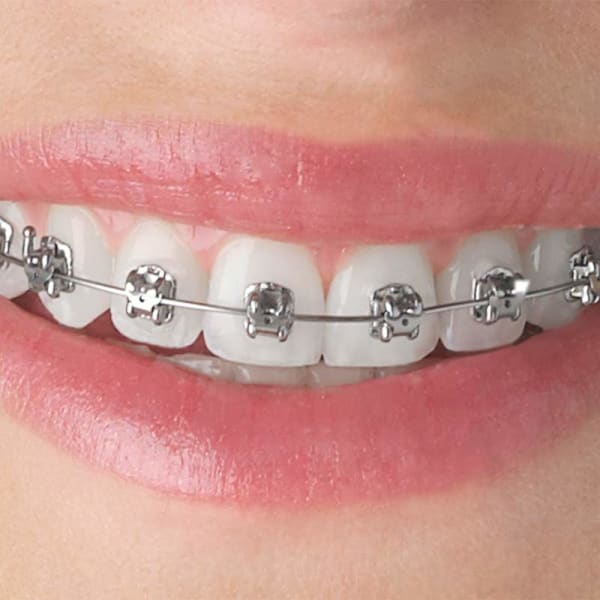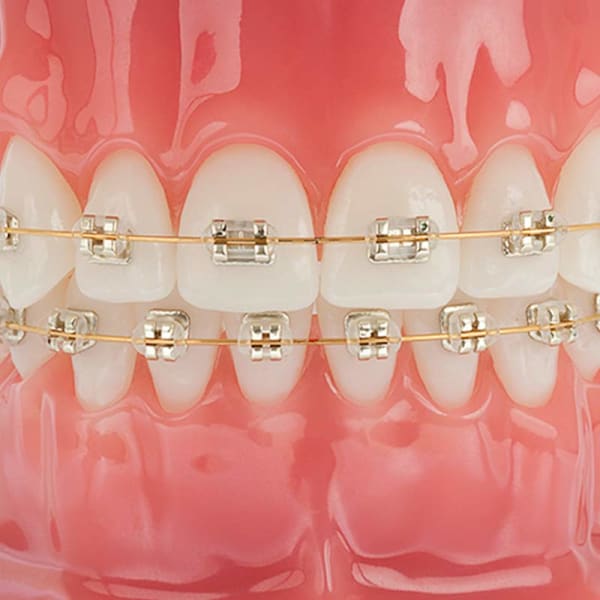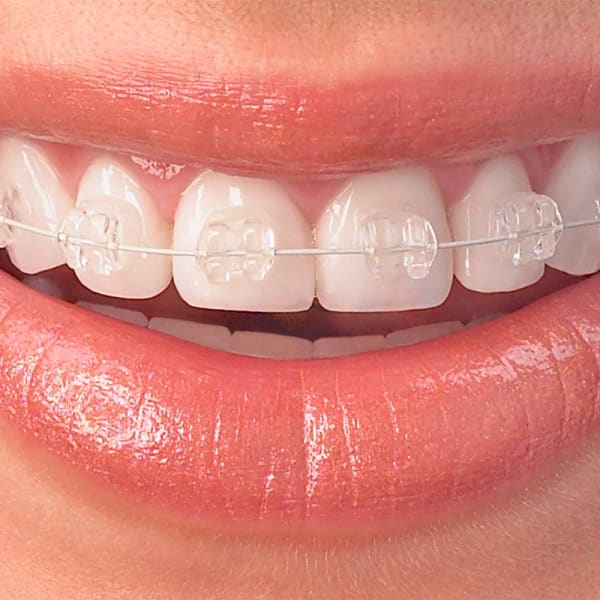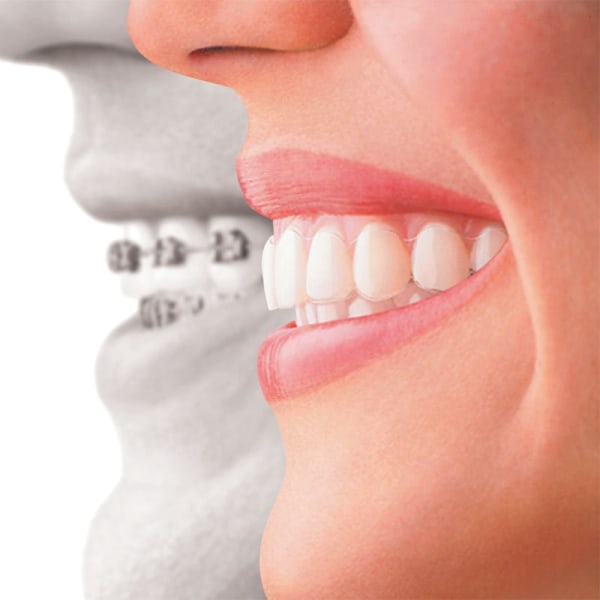Braces
Braces for Any Style and Budget
Braces are a key component in most orthodontic treatment plans. Rachel E Reichard Orthodontics offers patients of all ages multiple types of braces.
Topics on This Page:

Braces Are Dental Devices That Correct Bite and Jaw Problems
Braces straighten and align teeth. Braces correct a wide variety of tooth, bite and jaw problems. They apply low, constant pressure to move teeth into the desired position.

We Offer Many Types of Braces
We have multiple options for braces that vary in style, cost and function. Dr. Reichard will discuss what options are recommended for you during your consultation. All braces options are FDA-approved and American-made.

Most of our patients use these mini stainless steel braces. Unlike the large and ungainly metal braces of the past, today’s metal brace brackets are smaller.
Silver in color, these braces consist of stainless steel brackets adhered to your teeth, metal wires that connect the brackets across your teeth and small elastics that hold the wires in the brackets to help move teeth.
Patients can choose from a variety of colored elastics for a more colorful, unique smile or clear elastics.

Gold braces are definitely a statement piece.
Gold braces are made of stainless steel and function just like their silver counterparts, but the brackets and wiring are coated with a thin layer of gold.
Gold braces cost a bit more than traditional stainless steel.

Ceramic braces blend better into your teeth and are less visible than traditional stainless steel braces. These braces function just like their metal counterparts, only the brackets are made from a clear ceramic material.
Ceramic braces are more susceptible to staining and cannot withstand as much force/tightening as metal braces, so they may not work for every patient.

This popular option straightens teeth without the brackets or wiring, and serves as an alternative to standard braces. Rachel E Reichard Orthodontics is an Invisalign Gold Provider.
Aligner trays made of hard, clear plastic are custom molded to your mouth and fit over your teeth. We fabricate a series of trays that incrementally move your teeth over time. Patients typically wear a tray for 1-2 weeks, then change to the next tray.
Aligner trays must be removed before eating and drinking and make oral hygiene easy to keep up with, but should be worn for at least 20 hours per day.
Some patients may require additional components like spacers, springs or headgear as part of their treatment plan. Once braces are removed, most patients wear a retainer to help keep teeth in position.
The Big Day – Getting Your Braces On
Excited? Nervous? Maybe a little bit of both? It’s all normal and Dr. Reichard and the team will help you each step of the way. It typically takes around an hour to put on most types of braces. We promise this part of the process doesn’t hurt or have any needles. Here’s what you can typically expect:
Step 1
One of our team members will thoroughly clean and dry your teeth.Step 2
Dr. Reichard carefully applies a bonding adhesive to your teeth.Step 3
Dr. Reichard places and positions brackets on your teeth, then hardens the adhesive with a special light.Step 4
Dr. Reichard runs the archwires through the brackets and applies any additional components like elastics.Step 5
We’ll discuss how to take care of your new braces and cover your appointment schedule for periodic adjustments.That’s it! Pretty easy peasy. Now, take care of your braces and wear them proudly!
Mild Discomfort Is Possible after Braces Placement and Periodic Adjustments
Generally, braces do not “hurt”, but most people have some discomfort after their braces are first put on or when adjusted during treatment. After the braces are on, teeth may become sore or tender to biting pressures for the first three to five days. In these situations, over-the-counter pain reliever medications such as Advil or Tylenol will help to ease the discomfort.
Overall, orthodontic discomfort is short-lived and easily managed. Once patients have become accustomed to their braces, they may even forget they have them on. See more of our tips for making braces comfortable.

Individual Plans Vary, but Treatment Time Is Typically 1-3 Years
Treatment time depends on each patient’s specific orthodontic problem, recommended treatment plan and how well our plan/directions are followed. In general, treatment times range from 12 to 30 months. The “average” time frame our patients are in braces is approximately 24 months.
As your teeth will need time to firm into their new positions once the braces come off, most patients will wear a retainer to keep teeth in their proper position.
Braces Are Used for Patients of All Ages
Braces are typically employed for patients 10 or older, once most of the permanent teeth have begun erupting. Patients as young as age 7 may need braces to correct orthodontic problems early to prevent those problems from worsening as the child grows.
While most people think of braces as a child or teen treatment, many adults are choosing orthodontic treatment and braces. In fact, adults account for nearly 30% of orthodontic patients, according to the American Association of Orthodontics, and that number continues to grow. It’s truly never too late to change your bite and smile.

Many Factors Impact the Cost of Braces
Many components play into the cost of braces. As such, it is impossible to give an exact cost for treatment until we have examined you. We cover the exact cost and financial options during your final consultation. We discuss the many financing options available to accommodate your needs. Additionally, we review your insurance policy and help maximize your benefit and file claims on your behalf.

Braces Require Easy, but Special Care for Maintenance and Cleaning
Braces do require some extra care, but are generally not difficult to take care of. Patients should brush and floss their teeth at least twice each day – in the morning and before going to bed. However, we strongly encourage patients to brush after each meal as well to remove any food debris from around the braces.
Remember, clean, healthy teeth and gums move teeth faster. While we will establish a schedule for periodic appointments with us, it is important for patients to also see their family dentist regularly for checkups and cleanings while in orthodontic treatment.
Beyond daily cleaning, patients should avoid hard, sticky, chewy and crunchy foods like ice, hard candy, raw vegetables, caramel, taffy, etc., to prevent damaged or broken braces. Also, avoid chewing on hard items like fingernails, pens or pencils.
Patients should wear a protective mouthguard when riding a bike, skating or participating in any sort of contact activity. Most brace emergencies can be handled at home with our self-care tips.
We will show each patient proper hygiene protocols as part of our treatment plan. You can read more about caring for braces on our Life with Braces page.